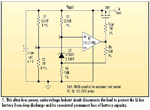Jester
Full Member level 6
I need to design a 12V lead acid battery charge circuit and also incorporate a low voltage cutoff circuit to prevent excessive battery discharge. I'm trying minimize part count.
One approach is to use a TI BQ24450 battery charge controller IC https://www.digikey.com/product-detail/en/BQ24450DWTR/296-24367-1-ND/2051746
And then add a cutoff circuit something like this (modified for say 10V):
1) Does this seem like a reasonable approach?
2) Assuming maximum charge current of 1A, can anyone recommend a suitable FET for SW1?
3) In a perfect world, perhaps there is one IC that incorporates both functions, does such an IC exist?
Suggestions welcome
One approach is to use a TI BQ24450 battery charge controller IC https://www.digikey.com/product-detail/en/BQ24450DWTR/296-24367-1-ND/2051746
And then add a cutoff circuit something like this (modified for say 10V):

1) Does this seem like a reasonable approach?
2) Assuming maximum charge current of 1A, can anyone recommend a suitable FET for SW1?
3) In a perfect world, perhaps there is one IC that incorporates both functions, does such an IC exist?
Suggestions welcome